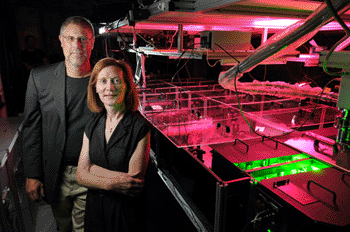Ultrafast Lasers Used to Create First Tabletop X-Ray Device
By LabMedica International staff writers
Posted on 11 Jul 2012
An international research team of physicists has generated the long-awaited first laser-like beams of X-rays from a tabletop device, paving the way for major advances in fields including medicine, biology, and nanotechnology.Posted on 11 Jul 2012
Scientists have been trying for half a century to build a cost-effective, reasonably sized X-ray laser that could, among other things, provide super-high-resolution imaging, according to Henry Kapteyn, a University of Colorado Boulder (CU-Boulder; Boulder, CO, USA) physics professor and fellow at the Joint Institute for Laboratory Astrophysics (JILA; Boulder, CO, USA), a joint institute of CU-Boulder and the National Institute of Standards and Technology (NIST; Gaithersburg, MD, USA). Most X-ray lasers require so much power that they rely on very large sized facilities. To avoid the need for a large energy source to power an X-ray laser, the CU-Boulder-led team has created a tabletop device that uses atoms in a gas to combine efficiently more than 5,000 low-energy mid-infrared laser photons to generate each high-energy X-ray photon, explained Margaret Murnane, a CU-Boulder physics professor and JILA fellow who is co-leading the research efforts. The new technology enhances the X-ray yield, provides a beam that exhibits high spatial coherence, and allows, in principle, the generation of pulses as short as 2.5 attoseconds.

Image: University of Colorado Boulder physics professors and JILA fellows Margaret Murnane, right, and Henry Kapteyn pose next to one of their laser devices (Photo courtesy of Glenn Asakawa/University of Colorado).
Such a device could also be used to peer into a single cell or chemical reaction to gain a better understanding of the nanoworld. "Because X-ray wavelengths are 1,000 times shorter than visible light and they penetrate materials, these coherent X-ray beams promise revolutionary new capabilities for understanding and controlling how the nanoworld works on its fundamental time and length scales," Prof. Murnane said, "Understanding the nanoworld is needed to design and optimize next-generation electronics, data and energy storage devices, and medical diagnostics."
Laser beams represent one of the best ways to concentrate energy and visible light laser beams have been a huge benefit to society by enabling the Internet, DVD players, laser surgery, and a host of other uses. "However, the same revolution that happened for visible light sources that made it possible to create laser-like beams of light for widespread use instead of multidirectional light from a light bulb, is only now happening for X-rays," noted Prof. Kapteyn.
The tabletop device -- an X-ray tube in the soft X-ray region -- produces a bright, directed beam of X-rays by ensuring that all of the atoms in a multiatmosphere pressure gas emit X-rays, according to Kapteyn. "As an added advantage, the X-rays emerge as very short bursts of light that can capture the fastest processes in our physical world, including imaging the motions of electrons," Prof. Kapteyn said.
The new devise has been described in the June 8, 2012, issue of the journal Science.
Related Links:
University of Colorado Boulder
National Institute of Standards and Technology
JILA













